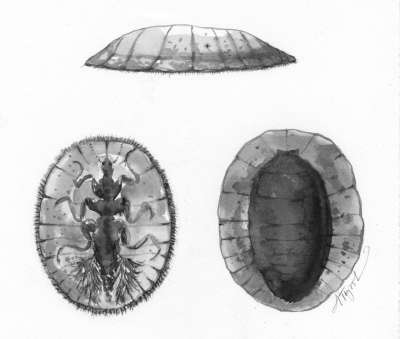
To see a stream’s smallest inhabitants, lie on a flat rock and duck your head underwater. A mask and snorkel help. You’ll be assailed by the effervescence of rushing water, the sibilance of shifting sand, the rhythmic knocking of unbalanced stones. If you’re lucky, you’ll see one streamlined brook creature that possesses such symmetrical perfection it’s hard to believe it is alive: the water penny.
At less than a half inch in diameter, and ranging in color from tan to green to brownish black, the water penny bears a faint resemblance to a prehistoric trilobite stuck to the side of an underwater rock. The small, speckled, oval body, perhaps tucked away in a crack or under a stone, echoes the dappled texture of the jumbled rocks that form its habitat.
A water penny is the larva of the riffle beetle, which, as an adult, looks much like other “average” beetles. Riffle beetles are basically terrestrial but stay close to streams and water-splashed rocks protruding above the turbulent surface. Sometimes they bask in the sun on a dry rock, but often they crawl about underwater, making use of the insect version of scuba gear: they breathe from a blanket of air trapped in the water-repellent hairs that clothe their bodies. Their large claws grip rocks to keep them from being swept away in the swift current.
The adult riffle beetle is neither the dominant stage nor the subject of this essay. It lives only a short time and is believed not to eat at all. Its role in life is to reproduce. Mating takes place on the same wet stones it stays near, and it is underneath these that the female crawls to lay a mass of eggs in a spot protected from the violent current.
When the eggs hatch, the water penny larvae initially remain concentrated around the hatching area, but over their 2-year lifespan, the population becomes dispersed, although not without challenges. Many fail to survive the swift current and are swept away, possibly into the jaws of a waiting trout.
Although water pennies are adapted to living in torrential riffles, their distribution is determined by variations in stream turbulence. Is the water flowing too fast for the water penny to maintain a grip? Or too slow to provide a fresh supply of dissolved oxygen? Are crevices between rocks suitable for long-term occupancy, or are the rocks too unstable? Do particular stony surfaces provide sufficient algal coatings for grazing? Does the underwater, rocky terrain give way to sand and sediment, substrates that a water penny is unable to cling to?
To survive in these diametrically opposed conditions – rushing water above its body, craggy stones below – the two sides of the water penny’s body appear to belong to two completely unrelated animals.
From above, the water penny looks like a tiny limpet with a flattened top of wide, overlapping, segmental flanges whose flaring margins fit closely upon a rock. The streamlined, armored body allows a water penny to inhabit the boundary layer between solid substrate and rapidly flowing water. And because it’s flexible, the animal can also wedge itself into narrow crevices safely away from the stream’s turbulence.
The dorsal flanges of its carapace are fringed with fine hairs so that the supple animal can press itself against an uneven surface using hairs as the final contact. This fringe is also a filter that allows a little of the brook’s flowing water to enter, bringing oxygen to the gills. (Don’t try to keep a water penny in a jar or aquarium, because still water doesn’t contain enough dissolved oxygen, and the little insect will soon suffocate.)
While the smooth, featureless top offers no clue to its heritage, turn a water penny upside down and you’ll immediately recognize an insect’s body, complete with a movable head bearing mouthparts and tiny, dark eyes, a thorax with three pairs of clawed legs, and four pairs of delicate, tufted gills extending from either side of the segmented abdomen.
Once it was thought that a water penny resists water turbulence by using its body as a suction cup, but this is not the case. Compression from water flowing over the curved body does force the animal down against the substrate, but it’s not immobile. With its grappling-hook insect claws, it crawls across stones and logs, seeking new algal pastures upon which to graze.
Seven species of water pennies inhabit North American streams, but only those streams that are relatively free from pollution. Water pennies are among the most sensitive of our stream-dwelling invertebrates because they depend on a constant supply of oxygen that only clean, flowing water can provide. So if you happen to spot a water penny clinging to a rock in your favorite stream, you can rest assured that the stream is in good shape, too.

